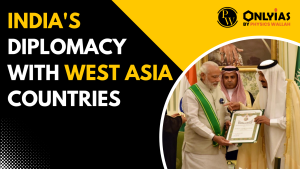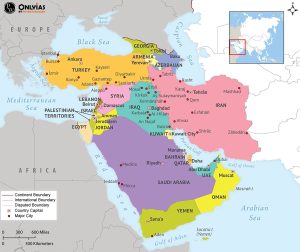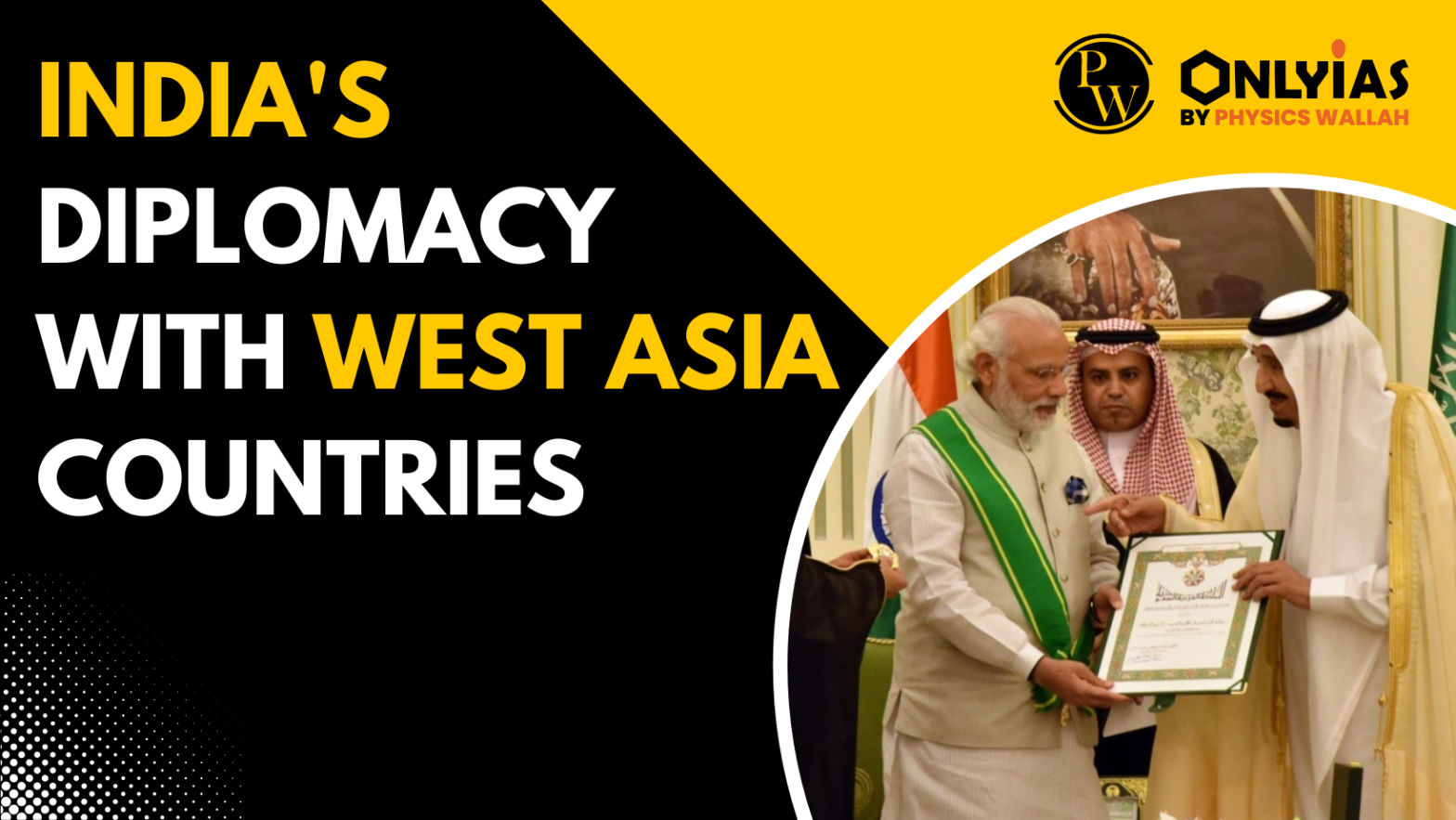 Subject: GS:02: International Relations
Subject: GS:02: International Relations
News Source: The Hindu
Context:
- West Asia countries are a part of India’s extended neighbourhood. Continued peace and stability in the region is of vital strategic interest to India.
Strengthening Ties With West Asia Countries
- The India-Middle East-Europe Corridor, announced at the G-20 summit , enhances New Delhi’s standing.
- It seeks to build an economic corridor from India’s western coast, through the Gulf (the UAE and Saudi Arabia), Jordan and Israel, to the Mediterranean, bringing India and Europe closer.
What Constitutes West Asia?
- The West Asia countries region comprises 12 member countries: Bahrain, Iraq, Jordan, Kuwait, Lebanon, Oman, State of Palestine, Qatar, Saudi Arabia, Syrian Arab Republic, United Arab Emirates and Yemen.

India’s Ties with West Asia Countries:
- Historical Perspective: India considers West Asia countries as part of her extended neighbourhood. Further, India’s relations with West Asia countries have historical roots, including partnerships formed within the Non-Aligned Movement (NAM).
- Shifting Geopolitics and the ‘Asian Century’: A shift in global economic power towards Asia, driven by China and India, is reshaping traditional Western allies’ perspectives in West Asia countries.
- Stability Through Diplomacy: Agreements like the Abraham Accords and détente between Saudi Arabia and Iran, facilitated by China, have enhanced regional stability.
- India has established defense and technology partnerships with Israel.
- Regional Connectivity with West Asia Countries: India maintains historic ties with Iran and is involved in projects like the development of the Chabahar Port.
-
- The port acts as a hub for regional connectivity, connecting Afghanistan and Central Asia.
- Geopolitical Shift Towards Multipolarity: India has been strengthening its ties with West Asia Countries, especially with the UAE and Saudi Arabia.
- These partnerships have expanded beyond energy considerations to include defense, maritime security, counterterrorism, and cybersecurity.
- Look West policy: It focuses on maintaining strategic and economic relationships with West Asia countries, especially Arab Gulf countries, Israel and Iran.
- Strategic Oil reserves: Recently, an Indian company, ‘Renew Power’ has signed an agreement to establish a facility in Egypt with an investment of US$ 8 billion, which is the largest country and the region in the West Asia countries.
- Saudi Aramco signed an MoU in April 2018 with the Indian consortium (IOC, HPCL & BPCL) to acquire a 50 per cent stake in India’s largest refinery project ‘Ratnagiri Refinery & Petrochemicals Limited’ worth US $ 44 billion.
- Cultural Connect: West Asia countries are India’s extended neighbourhood with deep civilisational connect and historic and People to people roots.
- Their welfare is yet another dimension of India’s security imperatives.
- During the Covid-19 when several Vande Bharat Mission flights ferried many of our citizens while rendering urgent assistance to the extended neighbourhood in West Asia countries.
- Every year more than a lakh Indian Muslims go for Hajj in Mecca and Medina located in this region providing a binding force between two regions.
Also read: India-UAE Relations
Significance of West Asia Countries for India:
- Energy Security: Out of India’s total imports of crude oil, the share of the Gulf countries is about 60%. (Iraq- 22%, Saudi Arabia-18% [ORF Study])
- A large proportion of India’s refineries process the sulphur-heavy sour grades of crude that are produced in the Gulf region.
- Diaspora: West Asia countries hosts around 8.5 million Indians working in different sectors which is about 65 percent of the total number of Indians working abroad.(MEA)
- Remittance: The non-resident Indians (NRIs) annually send home about $40 billion, and account for more than 55% of the country’s total remittance inflows.
- As per the Reserve Bank of India (RBI), 82 percent of the total remittances received by India originated from seven West Asia countries: the United Arab Emirates (UAE), the United States (US), Saudi Arabia, Qatar, Kuwait, the United Kingdom, and Oman.
- Trade and investment: According to UN Comtrade database, Iran and the GCC member states accounted for a 15.3% share of India’s cumulative two-way merchandise trade from 2017 through 2021.
- The GCC’s Look East Policy: India’s Look West Policy has been complemented by the GCC member states’ “Look East” policy, aimed at fostering closer ties with Asian countries.
India’s stand on Palestine Issue:
- India has expressed solidarity with the Palestinian cause and supported the establishment of a sovereign Palestinian state.
- In 1975, India became the first non-Arab country to recognise the PLO as the sole representative of the Palestinian people.
- India invited it to open an office in Delhi, which was accorded diplomatic status five years later.
- In 1988, when the PLO declared an independent state of Palestine with its capital in East Jerusalem, India granted recognition immediately.
Also read: India-Israel Bilateral Relations |
Challenges in India-West Asia Countries Relations:
- Palestine Issue & India’s deepening ties with Israel: The long-standing and complex conflict between Israelis and Palestinians presents a challenge of balancing human rights violations and strategic interests for India.
- The conflict between the two states is rooted in a tussle between culture, religious identity, and land, primarily a control over the city of Jerusalem.
- While Israel claims the whole of Jerusalem as its capital, the Palestinians claim East Jerusalem as the capital of a future Palestinian state.
- Organization of the Islamic Cooperation(OIC): Since the 1990s, the OIC has been issuing statements and resolutions against India year after year, which India has rejected outright.
- OIC aims at promoting Islamic solidarity by coordinating social, economic, scientific, and cultural activities.
- China’ s role as peacemaker: China has emerged as the biggest trading partner and a major investor in the region. It is playing a bigger role as peacemaker, as evident in the Iran-Saudi reconciliation agreement.
- China’s Belt and Road Initiative involves significant infrastructure projects in the Middle East.
- Religious Extremism and terrorism: The rise of religious fundamentalism and its political manifestation in the form of jihadi radicalism and terrorism in West Asia countries is a cause of grave concern to India.
- India has its large Muslim population and there is ongoing militancy in Kashmir. India fears radicalization of sections of its Muslim population. Pakistan, under the slogan of Pan-Islamism, tries to exploit the situation.
- Energy dilemma: India continued oil purchases from Russia, even in the face of the severe U.S. and Western sanctions.
- Consequently, Iran is prompting India to also consider importing oil and gas from them. The situation presents a complex dilemma in the wake of US-imposed CAATSA sanctions.
- Weak labour Laws & Indian diaspora: Some West Asia Countries, especially Gulf States have not ratified core international Labour Organisation conventions protecting freedom of association and right to organise, which includes the right to strike and right to collective bargaining.
- For example: In UAE the labour laws are very much in favour of employers and the law enforcements are poor (McGeehan and Keane, 2008).
Also read: India Saudi Arabia Strategic relation: Bilateral collaboration and Beyond
Major Initiatives by India for the West Asia Countries:
- The Middle East Quad (I2U2) Initiative: The idea behind I2U2 (India, Israel, the U.S. and the UAE) is to connect South Asia, the Middle East, and the United States for economic, technological, and diplomatic collaboration.
- Vaccine Maitri Initiative: Vaccine Maitri is a humanitarian initiative undertaken by the Indian government to provide COVID-19 vaccines to West Asia countries.
- For Example: Saudi Arabia , were Bahrain beneficiaries of this initiative.
- Downstream Projects: India invited West Asia countries to invest in downstream projects in India’s hydrocarbon sector.
- The agreement on oil storage and management between Abu Dhabi National Oil Company and the Indian Strategic Petroleum Reserves Limited was signed in January 2017.
- It underscores that crude oil supply from UAE for the Mangalore cavern would be a significant transformational step in building a strategic partnership in the energy sector.

- Strategic Partnership in Energy Sector: Abu Dhabi awarded a major oil concession to an ONGC-led consortium from India in Lower Zakum.
- A High-Level Ministerial Taskforce has been created in order to keep track of various high-level promises and agreements.
- Technological Solutions: The RuPay card, a key initiative by India in the digital payment system, was launched in Abu Dhabi.
- Soft Power Diplomacy: India inaugurated the first Hindu temple in Dubai as a special gift to the Indian community by the UAE. Yoga, Bollywood, and Music are other dimensions of Soft Power.
Way Forward: Navigating West Asia Countries: India’s Strategic Imperatives Amidst U.S.-China Rivalry
- New Opportunities Amid U.S.-China Competition: The United States views India, given its size, economic strength, historical ties, and cultural connections with the region, as a valuable partner in shaping West Asia’s geopolitics.
- Multi-Engagement Approach: India’s overall policy for the West Asia Countries should be rooted in the idea of multifaceted engagement.
- It should not prioritize appeasing or containing any specific great power.
- Strategic Independence: India should aim to maintain a significant geopolitical role in West Asia Countries, regardless of U.S. involvement or China’s presence.
- The safety of trading sea lanes and anti-piracy and counter-terrorism collaboration are absolutely essential for interrupted supplies.
- Diversification of economies ties: Recognize the shift in oil-dependent economies toward renewable energy sources and embrace a green technology-driven development path, aligning with their vision spanning from 2025 to 2040.
- Protection policies for Indian diaspora: Sound bilateral labour policies need to be framed to address the issues concerning the Indian labour working in the West Asia countries.
Conclusion
- India’s strategic engagement with West Asia countries is anchored in historical ties and vital interests, spanning energy security, diaspora welfare, and regional stability. Amidst evolving geopolitical dynamics, India must pursue a multifaceted approach, uphold strategic independence, and adapt to economic diversification while safeguarding its diaspora in this critical region.
![]() 25 Sep 2023
25 Sep 2023

 Subject: GS:02: International Relations
Subject: GS:02: International Relations 

